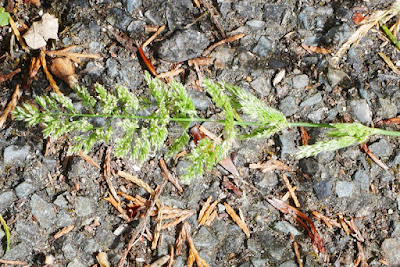Here are some of the amazing plants I found at this time in North Cornwall. Most trips out are on the spur of the moment for a few hours here and there rather than planned trips. As such, I'll highlight a few species from each trip to show you the best finds.
June is the time for orchids and there will be lots of them featured later. However, below is the very first Southern Marsh Orchid that I've seen in Cornwall and it was less than a mile from my house in a damp field corner. Of course, since then, I've seen thousands. They are very common here.
Dactylorhiza praetermissa
A visit to a local Common which also had several boggy areas revealed the first ever Oblong leaved Sundews that I'd ever seen too. It's much rarer than the common Round Leaved Sundew.
Drosera intermedia
Of course, most bogs have Common Cotton Grass too. It was a windy day and I managed to capture some of the grass (which is actually in seed) splayed out horizontal to the ground by using a very fast shutter speed.
Eriophorum angustifolium
The first Bog Asphodel of the Summer had come into flower right next to a Heath Spotted Orchid, delightful.
Narthecium ossifragum and Dactylorhiza maculata
I then found a rare orchid hybrid hiding behind some Western Gorse. It was the hybrid between Heath Spotted and Heath Fragrant Orchids. I'd never seen this hybrid species before and it was also a new record for the area.
X Dactylodenia evansii
It also had a lovely scent taking after its Heath Fragrant parent.
Below is a small part of Rosennnon Down, where the above plants were found. There are several such areas round mid Cornwall and each has its own flora. I look forward to exploring them in due course.
My next venue couldn't be more different than above, it was a brownfield site in Bodmin next to Home Bargains. It was on an industrial estate and was a cleared area of concrete full of plants having been abandoned and left undeveloped for a few years.
Very soon I found another new species, this time an alien species from New Zealand. At the time I did not know what it was, but I have since discovered it to be New Zealand Willowherb. The leaves are very distinctive and I've since found it in several urban areas.
Here is it's quite small flower.
Epilobium brunnescens
I then found two cudweeds, a speciality of dry brown field sites. The first was Jersey Cudweed, apparently spreading through England quite quickly now. The easiest way to identify it is that it is covered in silvery grey hairs so looks shiny.
The flowers weren't quite open yet, but they're minute anyway.
Laphangium luteoalbum
And Common Cudweed, such a cute wildflower. It's actually in the Daisy Family, so is related to Dandelions and Daisies, Thistles and Knapweeds.
Filago germanica
The final plant of note there was Heath Speedwell, there were loads of plants, all in flower, turning the ground blue!
Veronica officinalis
My next trip out was a proper field trip with the Cornwall Botanical Group. Below, we went to Harbour Cove and Tregirls Dunes on the Camel Estuary, both of which were stuffed with wildflowers.
Here's some of the group being shown Sharp Rush. It's so sharp and rigid, that the protruding spine at the top would take out an eye if you were careless enough to bend down near one.
Juncus acutus

Most were familiar with False Oat Grass as it grows almost everywhere. What I didn't know however, was that there was a subspecies that grew corms underground. However, you have to pull it up to verify it, unless you can get down low and pull away some soil to see the corm.
Arrhenatherum elatius subsp bulbosum
The Sharp Rush was a new species for me and so was this Sedge below. It had a super long bract going up and away from the fruiting body to distinguish it. No wonder it's called Long-bracted Sedge.
Carex extensa
Eyebrights are notoriously difficult to determine to species level, but these were relatively easy. Western Eyebright is the only Eyebright that has symmetrical flowers facing out in four directions. I took this above the flower photo to show it.
Euphrasia tetraquetra
Some Evening Primroses were in flower but looked odd. I took numerous macro photos of the relevant parts and the county recorder took a sample. We both later concluded the plant was a hybrid between Oenothera glazioviana (Large-flowered Evening-primrose) and Oenothera biennis (Common Evening-primrose). It was called Intermediate Evening Primrose, not very imaginative!
Oenothera x fallax
Of course, when looking at plants, you see some of the insects that feed on them. This is a Nettle Weevil which is irridescent blue
Phyllobius agg
There were of course many other interesting plants we saw that day including the hybrid between Ladys and Hedge Bedstraws. Organised field trips are always worth going on if you can attend, do so. I had to leave a bit early and missed several plants of interest so I will re-visit the area to find them soon.
After this, I returned to another common/bog, this time Retire Common, just west of Bodmin.There were some beautiful Early Marsh Orchids there too.
Dactylorhiza incarnata subsp. pulchella
A Golden Ringed Dragonfly waiting for the sun to come back!
Cordulegaster boltonii
A nice find was a few Marsh Speedwells, a rare species that lives in or very close to water.
Veronica scutellata
Another new Sedge, this one with floppy green bracts like droughted grass leaves. It's Common Yellow Sedge. It grew close to the ground rather than upright.
Carex demissa
There's so many more plants but the blog is becoming overlong, so you'll have to wait for part 2, coming soon to see them.
Take care
Dave























































